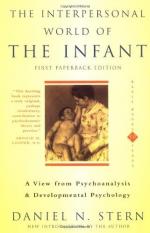
|
| Name: _________________________ | Period: ___________________ |
This test consists of 15 multiple choice questions and 5 short answer questions.
Multiple Choice Questions
1. Therapists should focus more on looking for narrative points of __________ in patients than to look at specific development stages.
(a) Movement.
(b) Activity.
(c) Emergence.
(d) Origin.
2. Stern states that affect attunement is a form of __________, rather than something else entirely.
(a) Development.
(b) Possibility.
(c) Attunement.
(d) Therapy.
3. At times, search strategies and certain therapeutic approaches cause therapists to overemphasize some problems in _______, while ignoring others.
(a) Development.
(b) Emergence.
(c) Families.
(d) Movement.
4. The sense of a core self is built out of patterns of __________ which maintain themselves in an equilibrium that becomes a sense of self.
(a) Movement.
(b) Experience.
(c) History.
(d) Interaction.
5. Stern sees the sharing of ________ states as the most important and the most clinically observable aspect of intersubjective relatedness.
(a) Motor.
(b) Impact.
(c) Effective.
(d) Affective.
6. Stern notes there is some evidence from _________ research to support the view that emotional states have an important organizing role.
(a) Criminal.
(b) Ancient.
(c) Adult.
(d) Memory.
7. Regulation through the Freudian notion of the _______ is always present, according to Stern's findings.
(a) Self.
(b) Ego.
(c) Id.
(d) Superego.
8. Stern would like his work to serve as a _______ for clinical practice and for family life as a whole.
(a) Analogy.
(b) Metaphor.
(c) Guideline.
(d) Calendar.
9. One indicator that might show possible future dangers for a core sense of self might be whether the infant's tolerance for ___________ is high.
(a) Understimulation.
(b) Learning.
(c) Noise.
(d) Overstimulation.
10. Stern begins to discuss how the client and patient should reconstruct an effective _________ about the past.
(a) Agreement.
(b) Picture.
(c) Narrative.
(d) Truth.
11. Traditional theories are limited because they think of the phases of development as being ______-specific.
(a) Action.
(b) Environment.
(c) Gender.
(d) Age.
12. _________ of sense of self also help to identify a helpful narrative point of origin for the therapist when working with a client.
(a) Interactions.
(b) Activities.
(c) Words.
(d) Domains.
13. __________ theory has also given intense emotional states an important organizing role, according to Stern's research.
(a) Spock's.
(b) Freudian.
(c) Psychoanalytic.
(d) Jungian.
14. The process of affect attunement is a bit of a mystery, though many have speculated that ________ is not enough to get the process off the ground.
(a) Education.
(b) Imitation.
(c) Understanding.
(d) Speculation.
15. _________ believed that in the first few months of life that an infant had a protective shield against stimuli that might affect development.
(a) Stern.
(b) Freud.
(c) Jung.
(d) Smith.
Short Answer Questions
1. Children, at this time, also begin to use personal _______ when referring to themselves and others, and they begin to engage in empathic acts.
2. What the infant enjoys and what reality is accepted arise together for the _________, not the latter after the former.
3. Sometimes equilibria form, but require a lot of ________ from others to maintain , according to Stern's findings.
4. By considering new experimental findings, Stern can begin to infer the _________ experience of the sense of self.
5. Stern doesn't like the idea of a barrier to stimuli because it is based on the idea of a period of life in which an infant is uninterested in ___________.
|
This section contains 470 words (approx. 2 pages at 300 words per page) |

|




